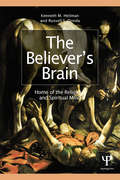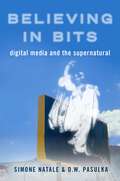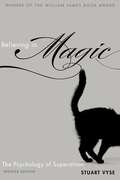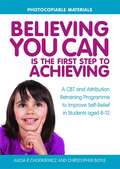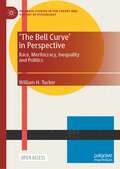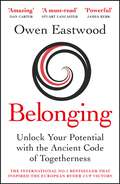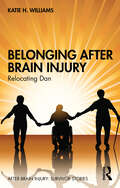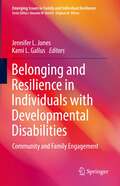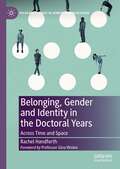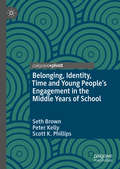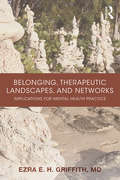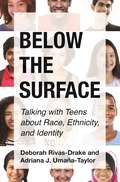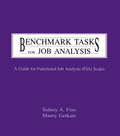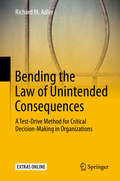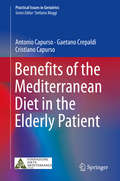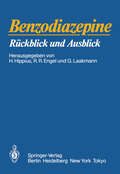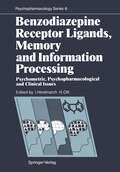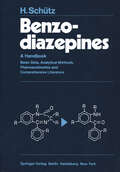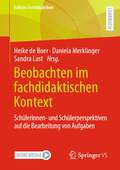- Table View
- List View
The Believer's Brain: Home of the Religious and Spiritual Mind
by Kenneth M. Heilman Russell S. DondaAbout 90% of people have faith in a supreme being, but our yearning for the divine, and whatever it promises, involves a large divergence in mental states and behaviors. Some adhere to doctrine, supplication, and fastidious religious practices; others have a strong sense they are part of something greater and more universal. However, all religious and spiritual paths are mediated by complex brain networks. When different areas of the brain are stimulated, a person can have a variety of experiences, but there is no specific ‘God spot’ where stimulation enhances religiosity or spirituality. Functional brain imaging shows that there are specific areas of the brain that ‘light up’ when subjects perform certain religious activities, but imaging only provides anatomic correlations, not functional explanations. The Believer's Brain takes a step beyond these singular methodologies, providing converging evidence from a variety study methods of how humans’ brain networks mediate different aspects of religious and spiritual beliefs, feelings, actions, and experiences. Although the book reveals how our brain is the home to the religious and spiritual mind, understanding this gift will not diminish our spirituality or our love or our belief in a supreme being, but will increase appreciation of the apparatus that mediates these mental states.
Believing in Bits: Digital Media and the Supernatural
Believing in Bits advances the idea that religious beliefs and practices have become inextricably linked to the functioning of digital media. How did we come to associate things such as mindreading and spirit communications with the functioning of digital technologies? How does the internetâs capacity to facilitate the proliferation of beliefs blur the boundaries between what is considered fiction and fact? Addressing these and similar questions, the volume challenges and redefines established understandings of digital media and culture by employing the notions of belief, religion, and the supernatural.
BELIEVING IN BITS C: Digital Media and the Supernatural
by Simone Natale, D. W. PasulkaBelieving in Bits advances the idea that religious beliefs and practices have become inextricably linked to the functioning of digital media. How did we come to associate things such as mindreading and spirit communications with the functioning of digital technologies? How does the internetâs capacity to facilitate the proliferation of beliefs blur the boundaries between what is considered fiction and fact? Addressing these and similar questions, the volume challenges and redefines established understandings of digital media and culture by employing the notions of belief, religion, and the supernatural.
Believing in Magic: The Psychology of Superstition - Updated Edition
by Stuart A. VyseWhile we live in a technologically and scientifically advanced age, superstition is as widespread as ever. Not limited to just athletes and actors, superstitious beliefs are common among people of all occupations, educational backgrounds, and income levels. In this fully updated edition of Believing in Magic, renowned superstition expert Stuart Vyse investigates our tendency towards these irrational beliefs. Superstitions, he writes, are the natural result of several psychological processes, including our human sensitivity to coincidence, a penchant for developing rituals to fill time (to battle nerves, impatience, or both), our efforts to cope with uncertainty, the need for control, and more. In a new Introduction, Vyse discusses important developments and the latest research on jinxes, paranormal beliefs, and luck. He also distinguishes superstition from paranormal and religious beliefs and identifies the potential benefits of superstition for believers. He examines the research to demonstrate how we can better understand complex human behavior. Although superstition is a normal part of our culture, Vyse argues that we must provide alternative methods of coping with life's uncertainties by teaching decision analysis, promoting science education, and challenging ourselves to critically evaluate the sources of our beliefs.
Believing You Can is the First Step to Achieving: A CBT and Attribution Retraining Programme to Improve Self-Belief in Students aged 8-12 (PDF)
by Christopher Boyle Alicia ChodkiewiczBelieving You Can is the First Step to Achieving is a fun and engaging programme for students in the upper primary years that teaches the difference between helpful and unhelpful thinking, increases self-belief and in doing so increases motivation to learn. Do you ever hear students using phrases such as "I'm not smart enough to do this?" or "I know I am going to fail?" Combining techniques from Cognitive Behavioural Therapy and Attribution Retraining, this programme teaches students the link between thoughts, feelings and actions, how to challenge negative thinking and how to celebrate success. The structured programme includes a photocopiable student workbook, role play games and other activity ideas, and all of the instruction and materials needed to easily implement the programme in any school. This will be an ideal resource for educational professionals looking to increase school attainment, support students who are underachieving, and encourage healthy and happy student development.
'The Bell Curve' in Perspective: Race, Meritocracy, Inequality and Politics (Palgrave Studies in the Theory and History of Psychology)
by William H. TuckerThis open access book examines the implications of The Bell Curve for the social, economic, and political developments of the early 21st century. Following a review of the reception of The Bell Curve and its place in the campaign to end affirmative action, Professor Tucker analyses Herrnstein’s concept of the “meritocracy” in relation to earlier 20th century eugenics and the dramatic increase in economic inequality over the past 30 years. Tucker demonstrates how, contrary to The Bell Curve’s predictions, the reallocation of these huge sums was neither rational nor beneficial for society. The book moves on to situate The Bell Curve within contemporary politics and shows how it can be seen to have played a role in the 2016 US election. This compelling analysis will appeal to scholars and those with an interest in the history of scientific racism, the history of psychology and the sociology of knowledge and science.This is an open access book.
Belonging: The Ancient Code of Togetherness
by Owen EastwoodWhakapapa. You belong here.Whakapapa is a Maori idea which embodies our universal human need to belong. It represents a powerful spiritual belief - that each of us is part of an unbroken and unbreakable chain of people who share a sacred identity and culture.Owen Eastwood places this concept at the core of his methods to maximise a team's performance. In this book he reveals, for the first time, the ethos that has made him one of the most in-demand Performance Coaches in the world.In Belonging, Owen weaves together insights from homo sapiens' evolutionary story and ancestral wisdom. He shines a light on where these powerful ideas are applied around our world in high-performing settings encompassing sport, business, the arts and military.Aspects of Owen's unique approach include: finding your identity story; defining a shared purpose; visioning future success; sharing ownership with others; understanding the 'silent dance' that plays out in groups; setting the conditions to unleash talent; and converting our diversity into a competitive advantage.
Belonging After Brain Injury: Relocating Dan (After Brain Injury: Survivor Stories)
by Katie H. WilliamsBelonging After Brain Injury: Relocating Dan explores the life of the author’s brother who has dealt with the effects of a severe traumatic brain injury (TBI) for over four decades. It recounts the institutional, psychological, and social labyrinths he and his family have navigated following the TBI he sustained at the age of eighteen. This insightful volume offers a holistic account of the impact of TBI on the survivor and his family. It reveals the difficulties a TBI survivor has had to endure and provides practical information about physical, psychological, and psychosocial symptoms and their consequences. Dan’s story offers new perspectives and strategies that will help alleviate seemingly intractable problems and highlights the central importance of forming connections with others in order to lead a fuller life. The author’s account of her own journey, learning to help care for and advocate for Dan, offers an invaluable guide for TBI survivors and those who care for and support them. Belonging After Brain Injury: Relocating Dan will be of interest to TBI survivors and their families. Its rich insights will be essential reading for medical and mental health professionals, as well those involved in the care and rehabilitation of TBI survivors and families.
Belonging After Brain Injury: Relocating Dan (After Brain Injury: Survivor Stories)
by Katie H. WilliamsBelonging After Brain Injury: Relocating Dan explores the life of the author’s brother who has dealt with the effects of a severe traumatic brain injury (TBI) for over four decades. It recounts the institutional, psychological, and social labyrinths he and his family have navigated following the TBI he sustained at the age of eighteen. This insightful volume offers a holistic account of the impact of TBI on the survivor and his family. It reveals the difficulties a TBI survivor has had to endure and provides practical information about physical, psychological, and psychosocial symptoms and their consequences. Dan’s story offers new perspectives and strategies that will help alleviate seemingly intractable problems and highlights the central importance of forming connections with others in order to lead a fuller life. The author’s account of her own journey, learning to help care for and advocate for Dan, offers an invaluable guide for TBI survivors and those who care for and support them. Belonging After Brain Injury: Relocating Dan will be of interest to TBI survivors and their families. Its rich insights will be essential reading for medical and mental health professionals, as well those involved in the care and rehabilitation of TBI survivors and families.
Belonging and Resilience in Individuals with Developmental Disabilities: Community and Family Engagement (Emerging Issues in Family and Individual Resilience)
by Jennifer L. Jones Kami L. GallusThis book examines belonging as a key protective factor for enhancing resilience for individuals with intellectual and developmental disabilities and their families. It focuses on understanding intellectual and developmental disabilities and resilience from systemic and social-ecological perspectives, emphasizing the roles of professionals, families, and communities in combating long-standing segregation and health disparities experienced by individuals and families. The volume explores the dimensions of belonging across diverse professional fields using a person-centered approach that acknowledges the significant lifelong role of family members and emphasizes reflective practice for professionals. Chapters present research and innovative strategies to facilitate belonging when working alongside individuals and families.Key areas of coverage include: Family-professional partnerships in working with individuals with intellectual and developmental disabilities across lifespan and community contexts. Spirituality, mental health, and identity in persons with intellectual and developmental disabilities. Research ethics and design in working with individuals with intellectual and developmental disabilities. The diverse needs, desires, and preferences of individuals with intellectual and developmental disabilities. The importance of individualized planning and approaches in fostering belonging for individuals with intellectual and developmental disabilities. Belonging and Resilience in Individuals with Developmental Disabilities is a valuable resource for researchers, professors, and graduate students as well as clinicians, therapists, and related professionals in developmental psychology, family studies, public health, and social work as well as related disciplines, including education policy and politics, behavioral health, and psychiatry.
Belonging, Gender and Identity in the Doctoral Years: Across Time and Space (Palgrave Studies in Gender and Education)
by Rachel HandforthThis book uses belonging as a lens through which to understand women students’ experiences of studying for a doctorate, exploring the impact of academic cultures on career aspirations. Drawing on discourses of neoliberalism and academic identities, it makes a valuable contribution to ongoing discussions of gender inequality in the academy. Based on data gathered from women doctoral students in the UK, this book offers a contemporary, research-informed understanding of the doctorate as an inherently gendered experience, which has implications for individuals, academic institutions, and for the future of the academic sector. The book will be of interest to academics working in the area of doctoral education, doctoral supervisors and those involved in doctoral student support, including researcher developers and individuals working in graduate schools, as well as doctoral students themselves.
Belonging, Identity, Time and Young People’s Engagement in the Middle Years of School
by Seth Brown Peter Kelly Scott K. PhillipsThis book explores the complex ways in which belonging, identity and time are entangled in shaping young people engagement with the middle years of school. The authors argue that these ‘entanglements’ need to be understood in ways that move beyond a focus on why individual young people engage with the middle years. Instead, there should be a focus on the socio-ecologies of particular places, and the ways in which these ecologies shape the possibilities of young people engaging productively in the middle years. Drawing on extensive qualitative data from an outer-urban metropolitan context, this book will appeal to scholars of sociology, education and policy studies.
Belonging, Therapeutic Landscapes, and Networks: Implications for Mental Health Practice
by Ezra GriffithWhy are certain places perceived to be therapeutic, to make people feel better about life, about themselves, and about their bodies? Could there be environmental, individual, societal, and attachment factors that come together in the healing process in both traditional and non-traditional landscapes? This observation is particularly important and has implications for the understanding of both healing and disruption in the lives of individuals. In Belonging, Therapeutic Landscapes, and Networks, Dr. Griffith examines factors that influence the intersection of health and place, one’s sense of belonging, and the constructing of therapeutic spaces that minimize psychosocial disruption in our daily lives.
Belonging, Therapeutic Landscapes, and Networks: Implications for Mental Health Practice
by Ezra GriffithWhy are certain places perceived to be therapeutic, to make people feel better about life, about themselves, and about their bodies? Could there be environmental, individual, societal, and attachment factors that come together in the healing process in both traditional and non-traditional landscapes? This observation is particularly important and has implications for the understanding of both healing and disruption in the lives of individuals. In Belonging, Therapeutic Landscapes, and Networks, Dr. Griffith examines factors that influence the intersection of health and place, one’s sense of belonging, and the constructing of therapeutic spaces that minimize psychosocial disruption in our daily lives.
Below the Surface: Talking with Teens about Race, Ethnicity, and Identity
by Deborah Rivas-Drake Adriana Umaña-TaylorA guide to the latest research on how young people can develop positive ethnic-racial identities and strong interracial relationsToday’s young people are growing up in an increasingly ethnically and racially diverse society. How do we help them navigate this world productively, given some of the seemingly intractable conflicts we constantly hear about? In Below the Surface, Deborah Rivas-Drake and Adriana Umaña-Taylor explore the latest research in ethnic and racial identity and interracial relations among diverse youth in the United States. Drawing from multiple disciplines, including developmental psychology, social psychology, education, and sociology, the authors demonstrate that young people can have a strong ethnic-racial identity and still view other groups positively, and that in fact, possessing a solid ethnic-racial identity makes it possible to have a more genuine understanding of other groups.During adolescence, teens reexamine, redefine, and consolidate their ethnic-racial identities in the context of family, schools, peers, communities, and the media. The authors explore each of these areas and the ways that ideas of ethnicity and race are implicitly and explicitly taught. They provide convincing evidence that all young people—ethnic majority and minority alike—benefit from engaging in meaningful dialogues about race and ethnicity with caring adults in their lives, which help them build a better perspective about their identity and a foundation for engaging in positive relationships with those who are different from them.Timely and accessible, Below the Surface is an ideal resource for parents, teachers, educators, school administrators, clergy, and all who want to help young people navigate their growth and development successfully.
Below the Surface: Talking with Teens about Race, Ethnicity, and Identity
by Deborah Rivas-Drake Adriana Umaña-TaylorA guide to the latest research on how young people can develop positive ethnic-racial identities and strong interracial relationsToday’s young people are growing up in an increasingly ethnically and racially diverse society. How do we help them navigate this world productively, given some of the seemingly intractable conflicts we constantly hear about? In Below the Surface, Deborah Rivas-Drake and Adriana Umaña-Taylor explore the latest research in ethnic and racial identity and interracial relations among diverse youth in the United States. Drawing from multiple disciplines, including developmental psychology, social psychology, education, and sociology, the authors demonstrate that young people can have a strong ethnic-racial identity and still view other groups positively, and that in fact, possessing a solid ethnic-racial identity makes it possible to have a more genuine understanding of other groups.During adolescence, teens reexamine, redefine, and consolidate their ethnic-racial identities in the context of family, schools, peers, communities, and the media. The authors explore each of these areas and the ways that ideas of ethnicity and race are implicitly and explicitly taught. They provide convincing evidence that all young people—ethnic majority and minority alike—benefit from engaging in meaningful dialogues about race and ethnicity with caring adults in their lives, which help them build a better perspective about their identity and a foundation for engaging in positive relationships with those who are different from them.Timely and accessible, Below the Surface is an ideal resource for parents, teachers, educators, school administrators, clergy, and all who want to help young people navigate their growth and development successfully.
Benchmark Tasks for Job Analysis: A Guide for Functional Job Analysis (fja) Scales (Applied Psychology Series)
by Sidney A. Fine Maury GetkateHuman resource practitioners are repeatedly faced with the challenge of effectively using language to clearly describe the work performed on a job. Functional Job Analysis--an internationally recognized and respected job analysis method --has been meeting this challenge for more than forty years. In this book, the authors show how human resource practitioners can use structured task statements and comprehensive rating scales to gain the perspective needed to map the domain of any job. In response to the demands of human resource practitioners, the book focuses on the seven scales used in Functional Job Analysis. More than 450 structured tasks were used to illustrate the breadth and scope of all the levels of these scales. These tasks can be used effectively as benchmarks to chart the work requirements of virtually any job. Personnel practitioners will find insights into the challenges of job analysis, as well as the tools needed to make job analysis more comprehensive, useful, and effective for human resources. Representing the most comprehensive information to date on the use of Functional Job Analysis scales for rating job tasks, this book: *addresses the problems of using language to clearly describe how work is performed on the job; *describes the relation between the need to carefully control the language of job analysis and the structure inherent in the Functional Job Analysis Worker Function scales--a conceptual link showing the reader that the key to understanding work is in the vocabulary used to describe work; *contains the most comprehensive treatment of the way to write clear and comprehensive task statements available in the job analysis literature; and *contains a sample task bank for the job of Functional Job Analysts--aiding the reader in understanding how a complete Functional Job Analysis should look.
Benchmark Tasks for Job Analysis: A Guide for Functional Job Analysis (fja) Scales (Applied Psychology Series)
by Sidney A. Fine Maury GetkateHuman resource practitioners are repeatedly faced with the challenge of effectively using language to clearly describe the work performed on a job. Functional Job Analysis--an internationally recognized and respected job analysis method --has been meeting this challenge for more than forty years. In this book, the authors show how human resource practitioners can use structured task statements and comprehensive rating scales to gain the perspective needed to map the domain of any job. In response to the demands of human resource practitioners, the book focuses on the seven scales used in Functional Job Analysis. More than 450 structured tasks were used to illustrate the breadth and scope of all the levels of these scales. These tasks can be used effectively as benchmarks to chart the work requirements of virtually any job. Personnel practitioners will find insights into the challenges of job analysis, as well as the tools needed to make job analysis more comprehensive, useful, and effective for human resources. Representing the most comprehensive information to date on the use of Functional Job Analysis scales for rating job tasks, this book: *addresses the problems of using language to clearly describe how work is performed on the job; *describes the relation between the need to carefully control the language of job analysis and the structure inherent in the Functional Job Analysis Worker Function scales--a conceptual link showing the reader that the key to understanding work is in the vocabulary used to describe work; *contains the most comprehensive treatment of the way to write clear and comprehensive task statements available in the job analysis literature; and *contains a sample task bank for the job of Functional Job Analysts--aiding the reader in understanding how a complete Functional Job Analysis should look.
Bending the Law of Unintended Consequences: A Test-Drive Method for Critical Decision-Making in Organizations
by Richard M. AdlerThis title provides managers, executives and other professionals with an innovative method for critical decision-making. The book explains the reasons for decision failures using the Law of Unintended Consequences. This account draws on the work of sociologist Robert K. Merton, psychologists Amos Tversky and Daniel Kahneman, and economist Herbert Simon to identify two primary causes: cognitive biases and bounded rationality. It introduces an innovative method for “test driving” decisions that addresses both causes by combining scenario planning and “what-if” simulations. This method enables professionals to learn safely from virtual mistakes rather than real ones. It also provides four sample test drives of realistic critical decisions as well as two instructional videos to illustrate this new method. This book provides leaders and their support teams with important new tools for analyzing and refining complex decisions that are critical to organizational well-being and survival.
Benediction (Plainsong #3)
by Kent HarufShortlisted for the Folio Prize.One long last summer for Dad Lewis in his beloved town, Holt, Colorado. As old friends pass in and out to voice their farewells and good wishes, Dad's wife and daughter work to make his final days as comfortable as possible, knowing all is tainted by the heart-break of an absent son. Next door, a little girl with a troubled past moves in with her grandmother, and down town another new arrival, the Reverend Rob Lyle, attempts to mend strained relationships of his own.Utterly beautiful, and devastating yet affirming, Kent Haruf's Benediction explores the pain, the compassion and the humanity of ordinary people.
Benefits of the Mediterranean Diet in the Elderly Patient (Practical Issues in Geriatrics)
by Antonio Capurso Gaetano Crepaldi Cristiano CapursoThis book illustrates the role of Mediterranean diet in connection with well-being and particularly its impact on health and elderly care, as well as on the mechanisms of aging. Aging is a natural process of human life. The knowledge that a healthy dietary regimen like the Mediterranean diet can effectively prevent or delay many diseases typically affecting aging people may help to better manage the aging process. From this point of view, knowledge of the numerous benefits of the Mediterranean-style diet may effectively promote better management of the burden of elderly care.As early as the 1950s, Ancel Keys pointed out the effectiveness of the Mediterranean diet in helping to control, and possibly avoid, myocardial infarction and/or cholesterol metabolism. Quite soon after the first studies were published, it became clear that the Mediterranean diet was beneficial not only in connection with cardiovascular disease but also many other diseases, from diabetes to hypertension, from cancer and thrombosis to neurodegenerative diseases, including dementia. Examining those benefits in detail, this book offers a valuable educational tool for young professionals and caregivers, as well as for students and trainees in Geriatrics and Nutrition.
Benzodiazepine: Rückblick und Ausblick
by Hanns Hippius Rolf R. Engel Gregor LaakmannIn allen klinischen Disziplinen der Medizin werden Benzodiazepine therapeutisch eingesetzt. Diese Entwicklung war nicht vorauszusehen, als vor 25 Jahren das erste Benzodiazepin-Derivat (Chlordiazepoxid) als "Ataraktikum", als "Tran quilizer" in der Psychiatrie eingeführt wurde. Inzwischen gehören die zahlreichen Benzodiazepine und wirkungsähnliche, strukturverwandte Pharmaka weltweit zu den am häufigsten verordneten Arznei mitteln. Das ursprüngliche Indikationsgebiet der Benzodiazepine bei psychiatri schen Patienten - die sogenannte Anxiolyse - ist längst nur noch ein Teilbereich der vielfältigen Anwendungsmöglichkeiten für dieses Arzneimittel. In einigen Indikationsgebieten (z. B. als Schlafmittel) haben die Benzodiazepine inzwischen ältere Medikamente (z. B. Barbiturate) völlig zu Recht sehr weitgehend verdrängt. Das Urteil über Nutzen und Risiken der Benzodiazepine hat sich in den letzten Jahren immer wieder einmal geändert. Jetzt sind die Meinungen oft so kontrovers, daß Benzodiazepine im Widerstreit völlig unterschiedlicher Ansichten stehen. Das hängt damit zusammen, daß man aus verschiedenen Perspektiven zu durchaus divergierenden Ansichten kommen kann. So wird der in der Praxis tätige Arzt womöglich anders urteilen als der Kliniker; der Nervenarzt kann zu einem anderen Urteil kommen als die Ärzte anderer Fachdisziplinen; der Anästhesist, der Suchtexperte, der klinische Pharmakologe, der Schlafforscher, der Epileptologe, der Psychotherapeut und der Toxikologe haben oft weit voneinander abweichende, manchmal sogar völlig konträre Ansichten über die therapeutische Bedeutung der Benzodiazepine - über deren Nutzen und deren Risiko. Aber nicht nur die verschiedenen fachlichen Perspektiven können zu unter schiedlichen Ansichten führen; auch aus der Perspektive eines einzelnen Fachs haben sich innerhalb der vergangenen 25 Jahre immer wieder neue, sich durchaus wandelnde Einschätzungen der Benzodiazepine ergeben.
Benzodiazepine Receptor Ligands, Memory and Information Processing: Psychometric, Psychopharmacological and Clinical Issues (Psychopharmacology Series #6)
by Ian Hindmarch and Helmut OttThe following papers were presented at an international workshop on benzo diazepine receptor ligands, memory and information processing, held during the 15th CINP meeting in Puerto Rico in December 1986 and organised by the editors and T. Roth. This workshop was aimed at reviewing and reflecting on past experience with benzodiazepines, evaluating the current state of knowledge of the actions of psychotropic orugs (particularly benzodiazepines, fJ-carbolines and benzodiazepine antagonists), and laying a basis of interest and speculation for future research into the potential use of these drugs in disorders of memory and information processing. There is much published material regarding the theoretical underpinnings of what psychologists call "memory", and doubtless there will be several more libraries filled with theses on the topic before a consensus is reached as regards basic definitions or even meaningful distinctions between for example, "short" and "long"-term memory - everyone has his own particular theory. The qualitative and quantitative diversity of the different approaches might seem to present an insurmountable problem for the psychologist seeking a unified conceptual framework. In practice the various theories produce a plethora of pragmatic and experimental techniques for psychopharmacologists and clinicians to use when investigating drugs with putative amnestic or promnestic properties.
Benzodiazepines: A Handbook. Basic Data, Analytical Methods, Pharmacokinetics and Comprehensive Literature
by H. SchützTo comment at length on the importance of the benzodiazepines seems superfluous within the scope of this preface. No other class of active substances has experienced an even approximately compa rable advance in the past two decades. It is therefore not surprising that the formerly dominant barbiturates and bromocarbamides have had to give way in many fields to the benzodiazepines, which now rank first (Proudfoot and Park [1828]). Closely linked with the great therapeutic importance of the benzodia zepines are analytical problems. Detection and the determination of blood levels can be necessary under therapeutic aspects, for instance in working out optimally effective levels in the treatment of epileptic conditions ("drug monitoring"), but also in connection with questions at issue in toxicology and traffic medicine. A toxicological analysis can be subdivided into the following steps: Detection (identification including screening) Determination (e. g. blood, plasma or serum levels) Interpretation of the analytical results. This book is intended as a contribution to each of these chapters: The part "Analytical Data" (pp.I-122) gives a comprehensive collec tion of data, e.g. general and chromatographic data (TLC, GLC) as well as spectra (UV, IR, MS) of 19 commercial preparations, 23 important metabolites and 18 hydrolysis derivatives. Information about biotransformation and the possible formation of aminobenzo phenone derivatives is also given. The most important analytical methods are presented in an extensive review on pp.123-204 in order to make it possible to select the optimum method on the basis of the essential data.
Beobachten im fachdidaktischen Kontext: Schülerinnen- und Schülerperspektiven auf die Bearbeitung von Aufgaben (Edition Fachdidaktiken)
by Heike De Boer Daniela Merklinger Sandra LastIm Mittelpunkt dieses Bandes steht die videogestützte Beobachtung. Gefragt wird, wie sich Schüler*innen fachliche Aufgaben im Deutsch- und Sachunterricht aneignen. Zu allen Beiträgen liegen Videoszenen vor. Auf der Basis von Beobachtungsprotokollen werden Rekonstruktionen der Aufgabenbearbeitung vorgenommen. Fokussiert werden dabei nicht nur Mikroprozesse der Aufgabenbearbeitung, sondern auch die Perspektiven von Schüler*innen auf den fachlichen Lerngegenstand.
